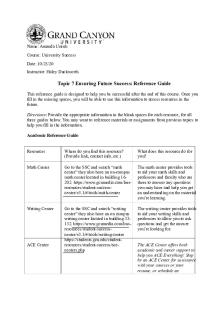2-1 Mass Communication Reference Guide PDF

| Title | 2-1 Mass Communication Reference Guide |
|---|---|
| Course | Intro to Communication |
| Institution | Southern New Hampshire University |
| Pages | 3 |
| File Size | 91.7 KB |
| File Type | |
| Total Downloads | 39 |
| Total Views | 128 |
Summary
A+...
Description
Communication Channels Reference Guide Name: Stephanie Clark Information in brackets [ ] should be used to guide your response and removed before you submit your assignment. Make sure to use the module resources and cite them in APA format. Mass Media Mass communication generally relies on technology to generate information to the general public (Primer on Communications, p. 4). There are many forms of mass media communication including social media, blogs, websites, radio, podcasts, television, and books (Primer on Communications, p. 4). You can utilize mass communication to reach a large audience quickly and effectively. In some forms, you can even initiate quick feedback. A communicator may use mass media to quickly disseminate information to a large audience. An example of this would be a presidential address which can be broadcast or streamed into homes across the country. Mass media communication can create an illusion of personal connection which is why it may be popular to the user (Primer on Communications, p.5). Common Types 1. Social Media: a. Twitter: A social media platform where users post and interact through microblogging, a practice of short, frequent posts. b. Facebook: A social media platform user can utilize to share pictures, articles, videos, and music with friends, co-workers, and followers. Followers are defined as people who have liked your page and opted in to receive updates on their newsfeed. c. Instagram: A social media platform used to share and edit photos and videos with followers. 2. Blogs a. Perezhilton: A shameless celebrity gossip site. b. The Drudge Report: A news aggregate blog which was part opinion and part fact sharing. Noted for breaking the Monika Lewinsky scandal. c. Modern Mrs. Darcy: A lifestyle blog for book nerds. 3. Websites a. Google: A search engine providing users with the most relevant results based on their search queries. b. Amazon: A multi-national e-commerce and streaming company. c. Zillow: An online real-estate marketplace company. 4. Radio a. The Rush Limbaugh Show: An American conservative talk radio program. Rush Limbaugh was the pioneer of conservative talk radio and had the highest-rated show on radio. b. On Air With Ryan Seacrest: Pop culture news, updates, interviews, videos, and music. c. The Dave Ramsey Show: Offers practical advice for long-term wealth building and financial goal setting. 5. Podcasts a. RadioLab: A storytelling and long-form journalism podcast that provokes thought and conversation about how listeners see and perceive the world.
b. The Ben Shapiro Show: A fast-growing conservative podcast discussing current news in culture and politics. c. The Joe Rogan Experience: A long-form conversation podcast from comedian, Joe Rogan. Interpersonal Communication Interpersonal communication is the foundation and building blocks of relational communication. It is the most personal form of communication and is structured by social expectations (Primer on Communications, p. 2). Interpersonal communication is used everyday to build relationships with friends, family, or coworkers. When building relationships, you inquire about the other person’s day, get to know their desires, their likes and dislikes. In business, interpersonal communication can be used during employee reviews. Business relationships may require more complex skills such as conflict management and listening skills (Primer on Communications, p. 3). Common Types 1. Face-to-face: a. Performance Review: During annual performance reviews, you meet with your supervisor and discuss your evaluation. This is an example where a business relationship adds a more complex skillset and conflict management and listening may need to be utilized. b. Daily Coffee Pickup: We get to know our baristas and develop a relationship with them. My barista is named Patty and she’s Brazilian. I have developed a relationship with her through interpersonal communication to learn these things about her. 2. Text Messages/Messenger: a. Friend: With three small kids, talking on the phone is a luxury reserved for naptime and nighttime. Texts can be utilized more frequently to stay in touch with my friends throughout the day and talk about what is going on in our daily lives. b. Sales: I often list my children’s outgrown toys and clothes on a local sale page. People contact me through messenger to negotiate and set up meeting times and places. Often people will tell me their stories about their need of an item if multiple people are interested. 3. Phone Calls: a. Personal Calls: By calling a friend or family member, we are building our relationship through interpersonal connection. b. Business Calls: When making a business call, we make polite conversation, or small talk, with the person on the other end of the line. Business calls are a dying art form as the directness of email has grown in popularity. Group Communication Group communication works toward a shared goal and consists of groups of three or more people (Primer on Communications, p. 3). Groups are often involuntary and task focused (Primer on Communications, p. 3). The goal is not relationship, but productivity. The relationships can sometimes interfere with the task-oriented nature of group communication (Primer on Communications, p. 3). Group communication is useful for goal-oriented individuals to get their task accomplished. In a business setting, project managers may utilize groups to collaborate and exchange information from various departments to work toward one company goal. An individual may form a collaborative group and
engage in this type of communication by finding experts in different areas to work toward the common goal all parties share. Common Types 1. School Groups a. Debate Team: Requires members of the team to create an argument and work toward presenting a resolution or topic. b. Band/Choir: Members play different instruments or sing at different pitches working together as an ensemble to produce a completed musical performance. c. Athletic Teams: Requires members of the team to perform unique roles to keep in sync and work toward a goal of defeating the opposite team. 2. Political Groups a. Republican Party or GOP: Often described as a conservative group. Heavy on traditional values and working toward a limited government role in economic issues. b. Democrat Party: A liberal group. Many players coming together to support a larger government role economically and social regulation. c. Green Party: This party’s platform is about environmentalism, grass-roots democracy, and social justice. 3. Board Groups a. Chapel Women’s Ministry Board: A group of 4-6 women with like-faith, but different denominations working together toward a goal of a successful military women’s ministry group as commissioned by the military. b. School Board: A group of educators and parents working side-by-side implementing policy, vision, and goals for the schools in their purview. c. Non-Profit Board of Directors: A governing body over the non-profit. They oversee activities and meet periodically to vote on the goings-on of the organization. References “A Primer on Communication Studies, Chapter 1.1” by Southern New Hampshire University is a derivative of “A Primer on Communication Studies Chapter 1, compiled by Andy Schmitz, which is licensed under Creative Commons by-nc-sa 3.0. “A Primer on Communication Studies, Chapter 1.1” is licensed under Creative Commons by-nc-sa 3.0....
Similar Free PDFs

Evolution of Mass Communication
- 4 Pages

Mass communication test 1
- 4 Pages

Mass communication notes
- 61 Pages

reference guide
- 2 Pages

Reference Guide
- 6 Pages

Oscola quick reference guide
- 1 Pages

Reference-Guide-2017
- 73 Pages

UNV103-Reference Guide
- 4 Pages

Reference Guide-Trad Gingerichc
- 4 Pages

UNV Reference Guide
- 5 Pages

COM 127 Reference Guide
- 3 Pages

Soc-sociology reference guide
- 18 Pages

Topic 7 Reference Guide
- 6 Pages
Popular Institutions
- Tinajero National High School - Annex
- Politeknik Caltex Riau
- Yokohama City University
- SGT University
- University of Al-Qadisiyah
- Divine Word College of Vigan
- Techniek College Rotterdam
- Universidade de Santiago
- Universiti Teknologi MARA Cawangan Johor Kampus Pasir Gudang
- Poltekkes Kemenkes Yogyakarta
- Baguio City National High School
- Colegio san marcos
- preparatoria uno
- Centro de Bachillerato Tecnológico Industrial y de Servicios No. 107
- Dalian Maritime University
- Quang Trung Secondary School
- Colegio Tecnológico en Informática
- Corporación Regional de Educación Superior
- Grupo CEDVA
- Dar Al Uloom University
- Centro de Estudios Preuniversitarios de la Universidad Nacional de Ingeniería
- 上智大学
- Aakash International School, Nuna Majara
- San Felipe Neri Catholic School
- Kang Chiao International School - New Taipei City
- Misamis Occidental National High School
- Institución Educativa Escuela Normal Juan Ladrilleros
- Kolehiyo ng Pantukan
- Batanes State College
- Instituto Continental
- Sekolah Menengah Kejuruan Kesehatan Kaltara (Tarakan)
- Colegio de La Inmaculada Concepcion - Cebu


